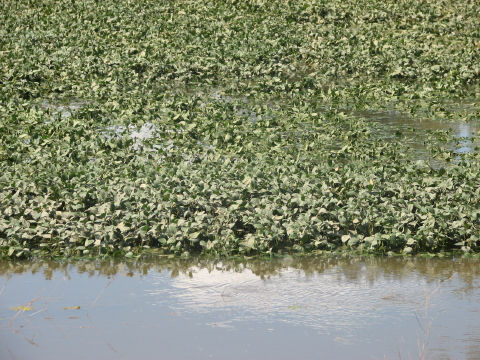5 MIN READ
Mid-Vegetative Soybean Flooding and Water Logging
May 31, 2020
Soybean Stage and Soil
Soybeans can be at a variety of growth stages during midseason. Partially submerged plants have an increased chance of survival compared to completely submerged soybean plants. Water-logging, where roots are flooded without plant submergence, is also common. Several factors influence potential soybean damage:
- Growth stage during flooding/ponding
- Length of time plants were flooded/ponded
- Temperature (soil and air)
- Drying rate and soil type
Effects on Yield
In addition to plant death from disease and physiological stress, yield loss results from reduced root growth, shoot growth, nodulation, nitrogen (N) fixation, photosynthesis, biomass accumulation, and stomatal conductance.
- Soybeans completely submerged for 48 to 96 hours generally survive.1,2
- Flooding for four (or more) days delays plant growth, shortens plants and reduces node number.
- Flooding for six days or more is expected to have a negative effect on yield.
- A wide range of yield loss may be experienced depending on environmental conditions and soil types (Table 1). In cooler temperatures, submerged plants are expected to live longer due to slowed respiration. Warm temperatures increase respiration and oxygen in the soil is consumed quickly.3
- A single flood event during bloom stage is less damaging compared to flood events at both bloom and pod fill.4
- Soybeans in the vegetative stages are more tolerant of extended periods of standing water compared to the reproductive stages.4 Potential soybean yield loss from water-logging could be 17 to 43 percent during vegetative stages and 50 to 56 percent during reproductive stages.2 Effects of flooding on specific plant growth and yield components can be found in Table 2.


Effects on Nodulation
Soybean growth and development depends on N availability as the nutrient is in high demand, especially during seed development. The N2 fixation process is sensitive to lack of oxygen and flooding can lead to reduced fixation. Fields with low soil organic matter experiencing dry conditions in August and September are expected to have a response to midseason flooding. Regions in the United States with midseason flooding and insufficient rainfall later in the season have developed low-protein crops. Actual yield loss would be difficult to calculate; however, low protein levels are an indication of yield loss in fields.1
Management
- Supplementing flooded soybean crops with N has not been shown to be an economical practice.
- Farmers with a soybean crop replanted after July 1st could experience a potential yield loss of 0.5 bu/acre/day.1 Therefore, a replant should be considered before mid-July to get a harvestable crop.
- Consider the remaining soybean stand. When 80,000 to 100,000 living plants per acre remain in uniform distribution, the field may approach full yield potential.2
- Living plants should be scouted when soils are getting dry enough for equipment to drive on. Darkened or soft growing points indicate a dead plant. Stems can be split lengthwise for inspection, as plants may have been simply covered with mud or residue from receding water.
- There may be genetic variability in soybeans for flooding tolerance in maturity groups II and III.2 Soybean products that have demonstrated good yield potential during flooding could be selected for frequently water-logged, low areas of fields.
- The presence of soil-borne diseases and differences in soil texture affects the response of plants to flooding. Midseason diseases – brown stem rot, sudden death syndrome, and phytophthora - could deteriorate roots and stems. These diseases may have infected plants earlier in the season or were laying dormant in soils before fields became flooded. Stressed plants, often in low spots or compacted soils, can develop disease symptoms after flooding. The severity of these diseases depends on genetic tolerance. Foliar diseases, including white mold and septoria brown spot, are favored by warm, wet canopy conditions that could prevail after flooding. These foliar diseases can be suppressed or managed with fungicides such as Delaro® 325 SC fungicide. To learn more about Delaro® fungicide, please visit https://www.cropscience.bayer.us/products/fungicides/delaro and contact your retailer.
- Weeds may take over a drowned-out area especially if a pre-emergence herbicide was washed away. Cover crops could be an alternative to replanting after insurance dates have passed.
In summary, fields should be evaluated after water recedes for plant survival and disease. Fields with adequate stand counts may achieve near normal yield potential. Disease pressure and soybean product tolerance influences the health of plants for the remainder of the growing season.
Sources:
1 Stahl, L., Coulter, J., Naeve, S., and Fernandez, F. 2018. Flooded fields and saturated conditions impact crops. University of Minnesota Extension. http://blog-crop-news.extension.umn.edu/2018/07/flooded-fields-and-saturated-conditions.html.
2 Conley, S. 2018. Assessing flood damage to soybean. University of Wisconsin. Integrated Pest and Crop Management.
3 Jean, M., Thelen, K., and Steinke, K. 2017. Managing corn and soybean fields submerged by recent, heavy rains. Michigan State University.
4 Griffin, J.L., and Saxton, A. 1988. Response of solid-seeded soybean to flood irrigation. II. Flood duration. Agronomy Journal. Vol. 80. pgs. 885-888.
Web sources verified 4/18/20
5015_S2
